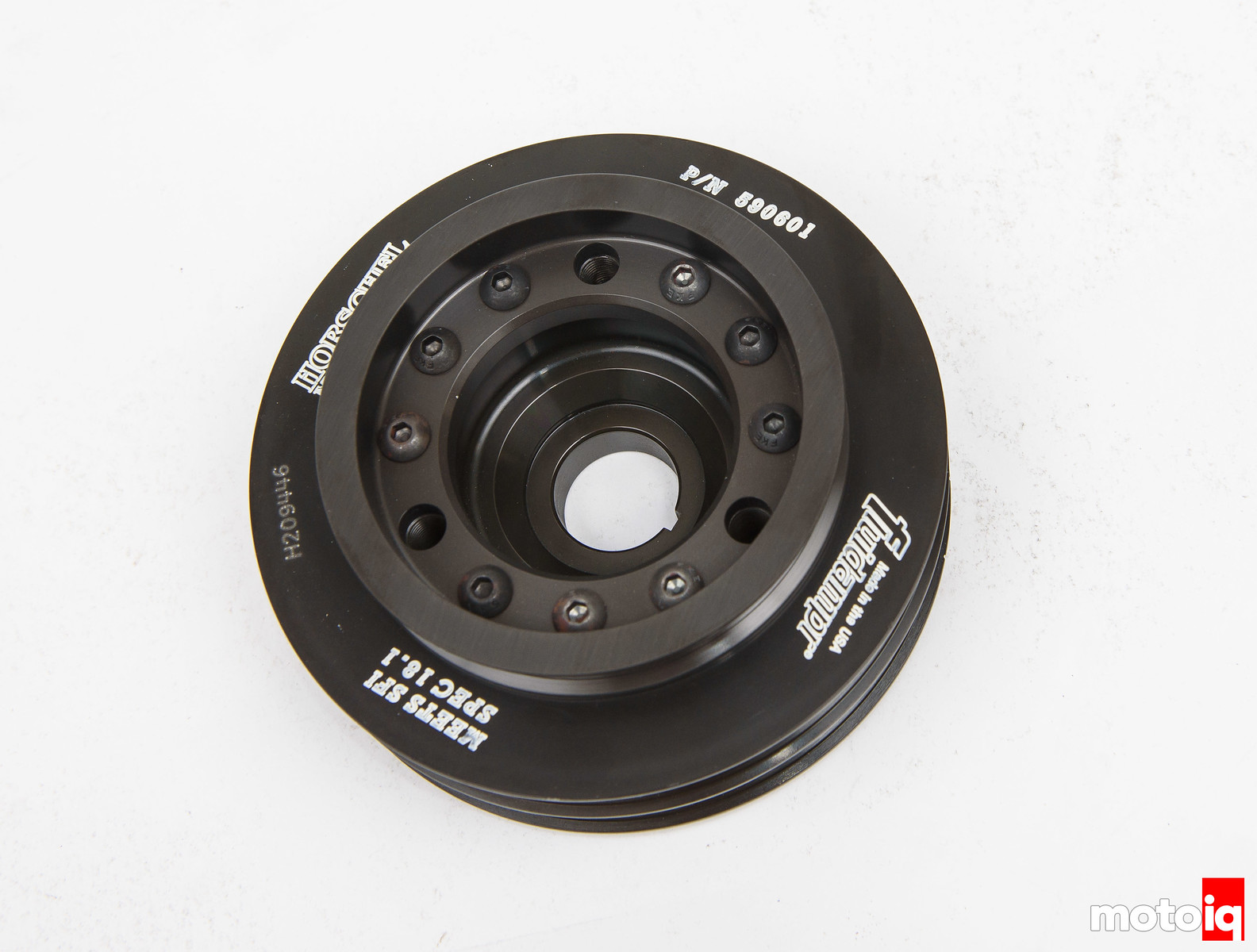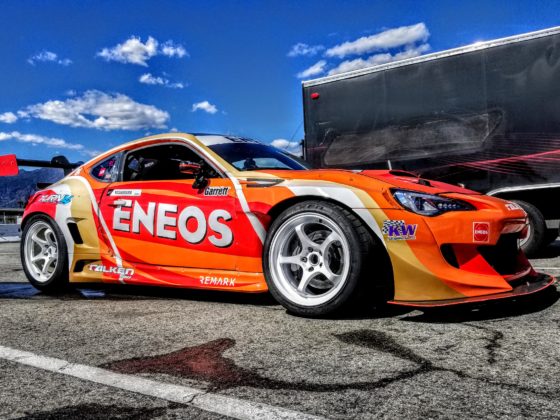
In laying down the base for some serious B series power that we have planned later, we decided to test out Fluidampr’s viscous harmonic balancer on our Project DC2 Integra’s currently bone stock B18C to see what effects it would have. A damper like this is designed to smooth out torsional vibration which is perhaps the most harmful type of vibration to the engine and the most detrimental to power.
Torsional vibration is not related to reciprocating balance as in making sure the pistons, rods, and crank are balanced to each other. Torsional vibration is the cranks whipping reaction to power impulses applied to it via the force of combustion events. The impulses applied to the crank add up to larger potentially damaging forces when the crank hits it’s natural or resonate frequency and increased harmonics of it, particularly 3rd and 4th orders as they can fall within the more stressed higher rpm ranges of operation. Engines with long and or flexible crankshafts are especially prone to crank whip, engines like inline 6 cylinders.
These large vibrations can cause engine damage like crank failure due to high cycle fatigue and bearing wear. As the whip can cause vibrations with an amplitude of over a degree in very extreme cases, it can cause spark scatter as the crank angles sensor gets whipped around. The uncontrolled fluctuations in timing that result from this can cause a loss of power and even engine damage. The whip can cause damage to belt driven accessories like Superchargers and dry sump pumps and even the alternator and power steering. It can also cause belt failure. So torsional whip can be bad, especially on racing engines and engines that are modified to make very high levels of power, high rpm operation and longer than stock stroke.

Conventional OEM harmonic dampers typically have a hub attached to the crank with a mass damper bonded to the hub with an elastomer. The weight of the mass damper is tuned to help attenuate vibrations in a certain range. A bonded rubber damper can only be tuned to work in a narrow RPM range. Sometimes an OEM will tune the damper to absorb vibrations in a lower order, lower RPM range that is bothersome in a normal cruising RPM range, not at a more destructive high RPM range. Some OEM dampers have two damping rings tuned to work at different frequencies to help get around this.
The Fluidampr gets around this by being amplitude sensitive instead of frequency sensitive. A Fluidampr has a steel flywheel housed in a laser welded housing that is attached to the crank. The housing is filled with a silicone goo that acts as a shear layer between the housing and flywheel. The silicone absorbs the torsional vibrational energy, the more the torsional movement, the more the silicone absorbs the force. This is independent of the frequency of the vibration.

The silicone fluid has a constant viscosity from -40 degrees to 300 degrees with low internal friction. It also has good heat conductivity so it can dissipate the heat generated from vibrational energy well which makes it a good damping medium.
The Fluidampr also is SFI Certified for safety to their 18.1 spec. This is a specific certification for harmonic balancers and includes requirements that the outer ring cannot separate from the hub in use and that the damper can tolerate being spun at over 12,500 rpm for over an hour with no damage.

The first step in the install was to loosen the power steering pump to get the belt off.




16 comments
How do you guys feel about the use of the single row OEM N1 crank pulley sold by Honda for the B series, which has been seen used on several Spoon cars with both B16B and B18C, and has no rubber ring at all?
Usually, for lower power NA engines with short stiff cranks, it is not an issue.
Actually for most flat plane cranks its not really that big of an issue if you don’t use a harmonic balancer. Harmonic balancers really show their worth on inherently unbalanced engines: Cross plane V8’s are the most common, but also straight fives like Volvo’s or VAG, or oddfire V6’s. Straight 3’s dont have that much benefit from it, Because of there length.
What you are seeing on the dyno is most likely down to resonance cancelling on the power end of the spectrum. But its still usefull for bearing life in general, even on straight 4’s or 6’s that don’t have heaps of power.
@ Mike Kojima: Have you run them on the flat fours? Because I recall you had some bearing issues? That might alleviate the problem somewhat. But what adds to the stress is solid mounting transmission and gearbox. The only remedy I have currently found is using balance shafts on flat 4’s with higher horsepower. or use a flat six of flat 4 with overlapping power strokes and be done with it….
P.s. I’ve sent email on writing via the email form on the site.
I ran it on my EJ25 and it made a huge difference in smoothness, to the point where the engine even sounded different! It did not result in any more power on the dyno although it has to help with engine stress. Your email got lost somehow. Can you email me directly at mike@motoiq.com?
Block flex is a mayor issue in the flat fours. In essence the same you are expiriencing with the V8 of Dai Yoshihara. In a sence both are caused by the conrods, and a bigger stroke doesn’t help one bit. Thats why I always use the biggest bore and the smallest stroke I can get away with.
We need to make instant torque and have a very wide powerband, hence the big stroke.
Oh, and sent it yesterday
Let me reply!
I got one of these for my FR-S, made a huge difference with my stiffened motor mounts. In terms of NVH, I at first thought the tachometer was lying – the engine was so much smoother, I couldn’t tell it was running.
I thought I read here that they’re developing one for new Miata, something so high-compression (13:1) can probably use some smoothing out. Have you heard anything about that?
We tested the Fluidampr on an FR-S and got good results. Check it out https://motoiq.com/fluidampr-the-independent-test/
Did you have any issue installing the pulley via Impact wrench? Due to your article, I have one on order for my track car (DC4). I’m slightly concerned as I’ve been reading various reports online about successfully installing via impact or needing the now that its discontinued $400 special tool
We didn’t.
LOOKING FOR THE BEST DAMPR FOR A STOCK 1957 270 CU IN GMC INLINE 6. THE STOCK ONE HAS COME APART AT THE RUBBER AND THESE ARE ALMOST IMPOSSIBLE TO FIND.
MAYBE TRY THE ONE IN THIS ARTICLE!
Is it worth it to install one of these harmonic balancers on a 4g63 engine from an
Evo 8/9?
We have it on ours.